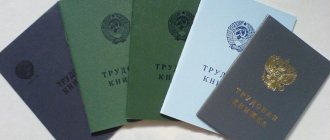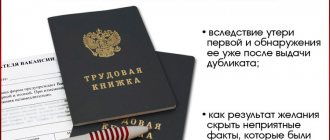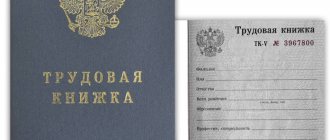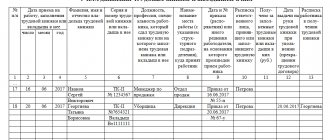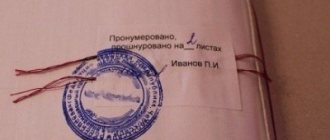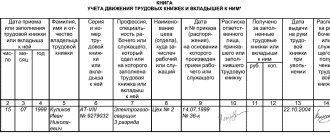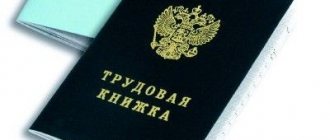The use of work records began in Europe in the 19th century.
However, due to numerous protests, the tradition did not take root. In Russia, work books appeared in 1918 and are still used today. Naturally, the external design and standards for filling out the document have undergone changes over time. Let's talk about how this happened.
Series and number of TC
Each genuine work document, printed at Goznak and transferred through intermediaries to the employer, has identification numbers that allow it to be distinguished from others. Almost immediately after the form is produced, identifiers establish strict control over it and accompany it all the way to the owner:
- As a result of the production of forms at Goznak, where series and numbers are controlled during production.
- When transferring work forms and inserts to an intermediary by proxy, where the list contains the identifiers of each form.
- When purchasing forms by the employer, during which the identifiers are also reflected in the list in the act of their acquisition and in the power of attorney under which they are acquired.
- When entering forms into the accounting book, which is stored in the accounting department, as well as in the application, according to which the authorized person receives the TC form and their inserts.
An already completed book, which has become the property of the owner, can always be identified in the following cases:
- loss (read what to do if you lost your book - here);
- theft;
- fakes.
It can be identified by series and number, and its entire path along the chain of movement to the owner can be traced. These circumstances may be important when restoring the Labor Code or during legal proceedings, as well as in other cases that cannot always be foreseen.
When applying for a new place of work, the owner’s work book is registered in the labor register, where its series and number are also reflected. That is, practically no legal action is carried out without indicating the unique number and series of the book.
In essence, the identifier is the face of the book, as well as the citizen’s personal data entered into it.
Identification numbers and series are entered into the TC in a specific way:
- In old books they are written in red paint and written on 10 pages: 1,5,9,13,17,21,25,29,33,37, repeating exactly.
- In the new ones - on 11 pages: 1,3,9,15,19,23,27,31,33,37,39. Their series are made in black paint, and the numbers are red.
Where to enter awards
Another question that comes up often. In the forms for transmitting information to the Pension Fund of the Russian Federation there is no column where the employee’s awards for his entire career are indicated. And what to do with these rewards? How to transmit information about them?
Ivan Shklovets: Unfortunately, yes, the new forms do not provide for such an option, which we included in the paper work book. If this is very important for the employee, he will apply to keep a paper work book, and all these awards will have to be written down there. They may be useful in the future, for example, for obtaining the title “Veteran of Labor”.
If a person has chosen an electronic book, then he himself must collect and store his awards - certificates, gratitude, orders for their announcement, in order to subsequently submit them to the relevant government bodies.
History of existence
The time of creation of the first labor force operating in the modern labor market was 1938. And today you can find them among workers who, due to their experience and good physical and mental health, continue to work. Their labor regulations were put into effect by order of the Council of People's Commissars of the USSR, approved on December 20, 1938 under No. 1320.
Until this moment, neither labor nor their analogues existed. By the time of their release, the concept that labor falsification could be carried out in the Soviet state was blasphemous. Therefore, neither a seal (see here) nor the signature of the responsible person was provided on their title pages, not to mention watermarks and other means of protection.
By 1974, these samples had become obsolete , since the work book had become an important document of national importance. The exchange of specialists from different republics required a political synthesis reflecting the meaning of the unity of workers, united by the slogan of the unity of the proletariat.
Based on these ideas, in accordance with the Resolution of the Council of Ministers of the USSR and the highest authority - the All-Union Central Council of Trade Unions, dated September 6, 1973, No. 656, it was decided to approve a new form of labor that meets modern requirements.
On April 21, 1975, “collective farmer’s work books” were approved, which became a global step in the history of labor legislation. Until 1975, many of the villagers, in principle, did not have the opportunity to leave their places of residence, completely deprived of documents.
https://youtu.be/UgjGFi6_h8A
How to determine the authenticity of labor
Despite the fact that such documents were issued strictly against signature, and access to them was limited, forgeries still occur. First of all, you can distinguish a genuine document from a fake one by the discrepancy between the years of issue and the entered dates for acceptance and departure from work, the beginning and end of activities at an enterprise or company.
However, this may not work. Fraudsters use many sophisticated technologies and have learned how to effectively forge documents. Therefore, a thorough examination will be required. Only a specialized laboratory can determine the time of release and the beginning of filling with an accuracy of up to a year. This is a rather expensive and lengthy data verification procedure. Therefore, it should be carried out only in special cases:
- when there are doubts about the entered data and this concerns the legal process, personal and important information for a person that can affect one’s career or life;
- there is a need to use labor information as an additional argument in restoring other documents;
- information is important for establishing length of service and obtaining a fair amount of pension upon recalculation or additional accrual.
A comparison of previously existing regulatory documents and the correctness of completion, in accordance with such national requirements, also provide grounds to confirm or refute the legitimacy of such paper evidence. For example, if a labor report is filled out for a collective farm employee before the introduction of the USSR collective farmer’s book, then the reliability of the entered data can be questioned.
Such nuances were strictly monitored and therefore errors, even if they existed, were corrected. At least, such gross errors could not go unnoticed during audits of accounting and maintaining personnel records of the enterprise. This remark applies not only to collective or state farms, but to almost any sector of the country’s economy.
What did the 1974 TK look like?
- Dimensions TC 10x14 cm.
- Hardcover in dark green vinyl or calico. Some samples are in a blue-gray cardboard cover.
- The cover depicts the USSR Coat of Arms
- Cover page for filling out information about the employee.
- With a tabular line in the middle of the book for entering information about the work.
- Inside, the columns can contain tabular data with entries in the language of the union republics.
All sheets are provided with single-color, clear “snake” type watermarks, which are clearly and clearly visible in the light.
It is generally accepted that work books of this period had 40 pages . However, this is not entirely true, given that among them there are numerous labor union republics, which also included graphs in the language of the union republic for whose use they were issued. Thus:
- Labor records of the RSFSR had records only in Russian and consisted of 40 pages.
- The labor union republics had records in two languages and consisted of 80 pages.
Sample of an old-style work book:
Where are the guarantees against leaks?
Are there any risks of data leakage about employees from the Pension Fund of the Russian Federation, since data even leaks from large banks?
Ivan Shklovets: The Pension Fund authorities are responsible for the safety of information about the work activities of employees and their pension rights stored in the information resources of the Pension Fund. Their employers are responsible for the safety of employees’ personal data.
Information received by the Pension Fund and stored in their information resources is protected and cannot be lost.
TC of the perestroika period, produced in 1992
After the collapse of the USSR and the adoption of the Constitution of the Russian Federation, as well as the labor legislation of the Russian Federation, the state system did not have the right to continue issuing a document adopted in the Soviet Union and bearing its symbols, as well as protective signs. In the 90s, the work book lost its relevance as a form of recording work experience for citizens of the USSR.
During the same period, samples of light blue color with a grayish tint . Apart from the color and thin cardboard cover, they were practically no different from the standard dark green books that were in wide circulation.
On legal grounds they were identical. During this period, quite a lot of printed products were produced that did not meet the standard, including TC. Therefore, work books from the nineties often do not meet the requirements.
To bring them to standardization, the state decided to include its series and number in red in the Labor Code.
A sample of what work books were in 1992:
Record of dismissal
The information about hiring also includes information about dismissal. The general rules on how to do this correctly are formulated in Resolution of the Ministry of Labor No. 69:
- Column 1 contains the serial number of the entry;
- Column 2 indicates the date of dismissal (termination of the employment contract);
- in column 3 a record is made of the reason for dismissal;
- Column 4 names the document on the basis of which the entry was made - an order (instruction) or other decision of the employer, its date and number.
Correspondence of series and numbers of work books by year of issue for old samples
| Series of work books (LC) | Year of production TC |
| AT-1 | From 1974 to 1976 |
| AT-2 | From 1977 to 1979 |
| AT-3 | From 1980 to 1982 |
| AT-4 | From 1983 to 1985 |
| AT-5 | From 1990 to 1992 |
| AT-6 | From 1990 to 1992 |
| AT-7 | From 1993 to 1997 |
| AT-8 | From 1998 to 2000 |
| AT-9 | From 2001 to 2003 |
| New shopping malls | 2004 |
Introduction of new TKO forms The main documents stating the regulations of the new type of TK, defining the principles of filling them out and working with them on the basis of new forms of management are:
- Resolution of the PRF dated April 16, 2003 No. 225, which includes Rules for working with new types of technical equipment.
- Resolution of the Ministry of Labor dated October 10, 2003 No. 69, containing Instructions for working with new labor standards.
The need to introduce new forms of forms has become ripe due to the fact that the Russian legal system has become stronger and has introduced new forms of recording labor activity, based on the provisions of the Labor Code of the Russian Federation and fundamentally new forms of management, radically different from the Soviet ones.
However, a decision was made to keep in use all accounting documents through which the labor activities of citizens are carried out and monitored.
Useful video
From January 2021, the usual paper versions of a document confirming the place and time of work of a citizen will become a thing of the past. A mechanism for electronic documents of this type is being introduced. This formulation is supported by the legislative framework, including the code regulating the relationship between employee and employer.
A citizen’s right to use two systems for recording his work activities remains - he can keep both paper and electronic versions. For the younger generation, such documents will no longer be registered in paper form, since a single database will be available for viewing by both the employee and the employer.
More information about the innovation, which will start working in the near future, in a useful video.
What do TCs from 2003 look like?
- TK 2003 release has dimensions 8.8x12.5 cm. The number of pages is 46.
- Hardcover in dark grey. This is usually paper or fabric vinyl.
- On the cover is the Coat of Arms of the Russian Federation.
- With a cover page for filling out information about the employee, which does not differ from the old samples.
- With a tabular layout in the middle of the book for entering information about the work, which does not differ from the old samples.
- Unlike the old books, it contains only graphs in Russian.
All sheets are protected with watermarks. Unlike the old samples, the signs here are multi-colored and have a complex pattern:
- Two-tone color, changing color towards the middle of the leaf.
- The mesh is quite fine, with a complex pattern.
- The letters "TK" are all over the sheet.
Sample of a new work book - what it looks like:
When was the new sample work book introduced, what are its features?
The main innovations related to labor are:
- presence of active protection;
- demanding strict accountability;
- availability of special distribution sites;
- technological innovations.
First of all, the emphasis of changing such documents was placed on protection against various types of falsifications. It is incredibly difficult to counterfeit an employee’s book, since thanks to modern technologies it is made from special material. Here are present:
- chemical blocking (protection);
- watermark;
- special seams (to prevent the removal of pages and other violations);
- microscopic hairs (ultraviolet);
- special inscription (ultraviolet).
The new workbook has forty-four pages. However, you can only purchase a book from organizations that are legally authorized to carry out this type of activity (distribution).
Correspondence of TK inserts to the years of their production
| Series of inserts TK | Year of release of the insert |
| AT-I | From 1974 to 1980 |
| AT - II | From 1981 to 1987 |
| AT - III | From 1988 to 1994 |
| AT - IV | From 1995 to 2003 |
| VT | From 2004 to present |
According to experienced personnel officers with extensive experience who have had the opportunity to work with old insert forms, their cover is much thinner, and so are the sheets. This fact made it much easier to sew the insert into the book (see here).
In addition, the forms have visible differences:
- In the old inserts, the Coat of Arms of the USSR was located in the upper left corner, and in the new ones - the Coat of Arms of the Russian Federation.
- Watermarks visible against light correspond to those applied to work books of the corresponding year of issue.
Unfortunately, irresponsible personnel officers, mainly in the 90s, committed serious violations in the preparation of inserts in the work book, which now affects the problems of citizens applying for pensions. Violations include:
- Sheets from another work book sewn or pasted into the TC.
- Regular sheets lined in the form of graphs.
- Inserts made in a simple typographic way.
These and other violations create a precedent for the unsuitability of the Labor Code.
In such cases, the employer has to warn the employee that his labor must be replaced in part of the glued liner.
How to fill out the insert
Each insert in the book, like the original itself, has its own number and series, which must be indicated on the title page of the insert. It is worth recalling that the work book insert cannot exist as a separate document. It is not recognized as valid without the original. This auxiliary document is filled out in the same order as the labor document itself.
To make it easier for the employer or his authorized employee from the HR department to determine the year of issue of a particular work record book that an employee presents, every year new samples are released with different series.
Allow me to report
How will electronic work records of civilian personnel be maintained in military units of the Ministry of Defense? Currently, access to the Internet in the territories of military camps in military units is prohibited.
Ivan Shklovets: The law allows not to transfer information to the Russian Pension Fund if we are talking about state secrets. As for military personnel, the Ministry of Labor is now preparing a special procedure for generating such information. And in the near future he will suggest what to do with them. If these are ordinary civilian employees in units that enter into employment contracts, everything is done in a general manner.
